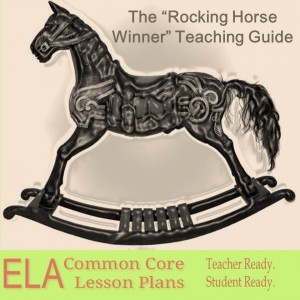There was an administrator who was not beautiful, who started with all the advantages, yet she had no administrative skills. She had bonny teachers, yet she could not love them. When she was present in a teacher’s classroom, she always felt the centre of her heart go hard.
And she’s coming to observe your class next Tuesday, so you need some good “Rocking Horse Winner” lesson plans with a “Rocking Horse Winner” summary and analysis.
You’ve found it.
Summary of “The Rocking Horse Winner”

Don’t gamble on lesson plans for “The Rocking Horse Winner” by D.H. Lawrence.
We find out immediately that Hester doesn’t love her children. She does love material things. The irony is she can’t get rid of her kids and she and her husband do not earn enough money to afford the material things she desires (at least she thinks she can’t). The kids sense this, especially Paul, Hester’s son.
The house senses this too, which is why it constantly whispers the need for more money. The reader may just think this is a figure of speech, but combined with the supernatural occurrences involving a rocking horse, maybe the house is whispering. There’s a fair amount of psychological ambiguity, but I’ve gotten away from my summary and prematurely jumped into analysis.
Back to the summary.
Paul innocently asks his mom one day why his Uncle Oscar has a car and they don’t. Hester’s response is that Oscar is lucky and Paul’s father is not. Paul declares that he is lucky and that he will bring money to the family.
In order to find his luck, Paul rides his rocking horse incessantly, believing that the horse will bring him luck. While riding the horse, Paul is able to determine winning horses at the track. The gardener, Bassett, partners with Paul and the two do quite well. Paul’s uncle finds out and he joins the two. The Rocking Horse’s ability to help Paul pick sure winners is remarkable.
Paul anonymously gives his mother 5000 pounds (worth about $290,000 in today’s money) for her birthday. Although it leads to many upscale purchases, it makes the voices in the house even worse.
Paul wants to win more than ever. Paul’s mother enters Paul’s room one night as he’s riding the horse. As he collapses from a brain fever, he mentions the name of a horse. The horse wins. Paul wins 70,000 pounds, giving him 80,000 total (over $4.5 million in modern money). Everyone is rich. Paul dies.
Literary Analysis of “The Rocking Horse Winner”
- Symbolism. Symbols in “The Rocking Horse Winner” include the horse (duh), luck, the house, the shiny objects in the house, and if read as an allegory, the indivduals in the story.
- Irony. Hester wants whatever she doesn’t have. When Hester gets what she wants, it doesn’t make her happy. Even though it doesn’t make her happy, she wants more of it.
- Supernatural. Initially, the house-whispering and other such utterances seem figurative only, but as the story progresses it becomes clear that there’s more literalness to the story than initially suspected.
- Theme. Themes in “The Rocking Horse Winner” include gender roles in marriage, the destructive force of materialism, psychological trauma caused by crappy parenting, the role of luck, and there’s a definite element of Freudian sexuality and all that stuff that’s embarrassing to talk about with your mom.
- Appearance vs. Reality. This ties in to both theme and irony. From the beginning of the story it’s apparent that things aren’t as they seem. The good mother isn’t really good. The good Uncle Oscar isn’t really good. Luck isn’t really luck.
Lesson Plan Ideas for “The Rocking Horse Winner” by D.H. Lawrence
Before you go any further, I want you to know I’m a big fan of graphic organizers. I’m also a big fan of giving teachers something they can use right now: Analyzing Irony in Literature.
- Irony in Literature Lesson Plan. Just click at that link above and you will have a winner of your own.
- Symbolism in Literature. Make a chart. Column 1 is a symbol from the story. Column 2 is an explanation using that symbol.
Last Updated on April 20, 2018 by Trenton Lorcher
Share This: